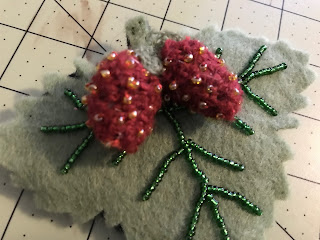This was just supposed to be just the traveling port folio from the Workwoman's Guide but turned into quite a project!
The portfolio is made from bookboard and covered in black silk trimmed with green and brown silk ribbon. It is filled with a turtle pen wiper, pen nibs, a bone pen, a horn pen, two pencils, tapers, a seal, sealing wax, a letter opener, and a knife. It turned out cute!
The 1860s writing desk was put together with mostly the same items, except I added stamps and gummed envelopes for events post 1858.
For both desks, I made my own ink out of walnut shells which was a fun experience. Then I made SEVERAL pen wipers. I'm going to take 2 of them to sell at the Texas Living History Association's auction.
Aside from the turtle one, I made two pinwheel pen wipers, one with a crochet top and bottom with ceramic squirrels on top, and another plain with just a china button.
Then I made a strawberry pen wiper based off this original from Peterson's Magazine, 1865:
I used glass beads for the veins and crocheted the strawberries. The actual directions I used were something of this sort:
Chain 4, then join with the 1st chain with a slip stitch
Single crochet around (4 stitches)
2 single crochet in each stitch around (8 stitches)
Single crochet around (8 stitches)
Single crochet around, but increase every other stitch (12 stitches)
Continue in that pattern (plain row, increase row, plain row) until it looks like a strawberry. Stuff the strawberry then single crochet in every other stitch until the strawberry is closed. Tie off.
The little green stem bit was as follows:
Chain 5, single crochet back down, slip stitch in the 1st chain, chain 5, single crochet back down, slip stitch in the 1st chain, chain 5, single crochet back down, slip stitch in the lst chain. Then I stitched it on the strawberry and beaded the strawberry with yellow glass beads.
I also did an acorn pen wiper from an 1868 Godey's Lady's Book pattern.
I used real acorn hulls but crocheted the actual acorns using a very similar pattern to the strawberries, but smaller.
Chain 2, slip in the 1st chain.
Single crochet 4 times in 1st chain.
Do 2 single crochet in each stitch (8 stitches).
Single crochet across (8 stitches) x2
Stuff the acorn.
Single crochet, skip a stitch, single crochet until the hole is closed.
The project turned out super cute!






































